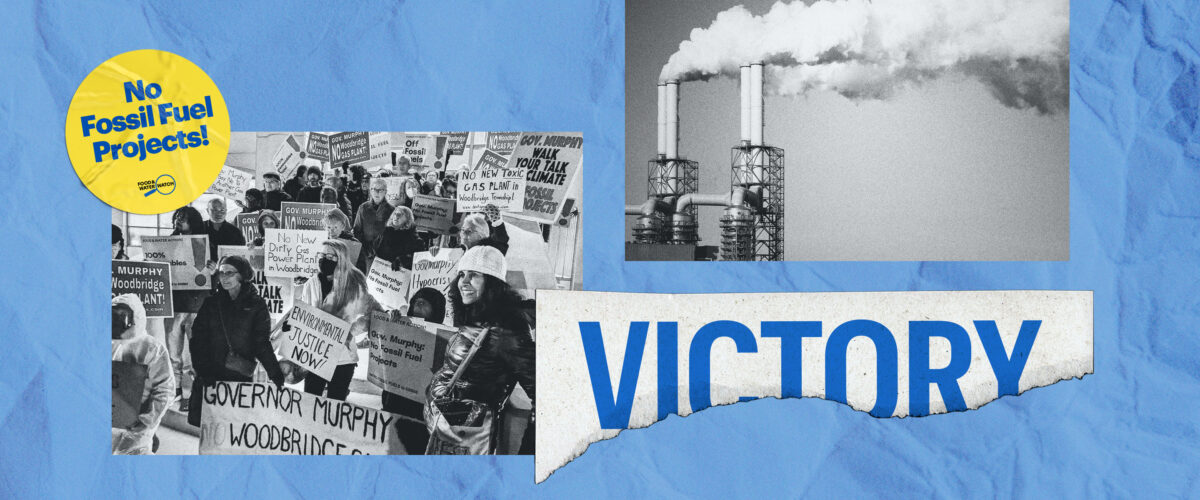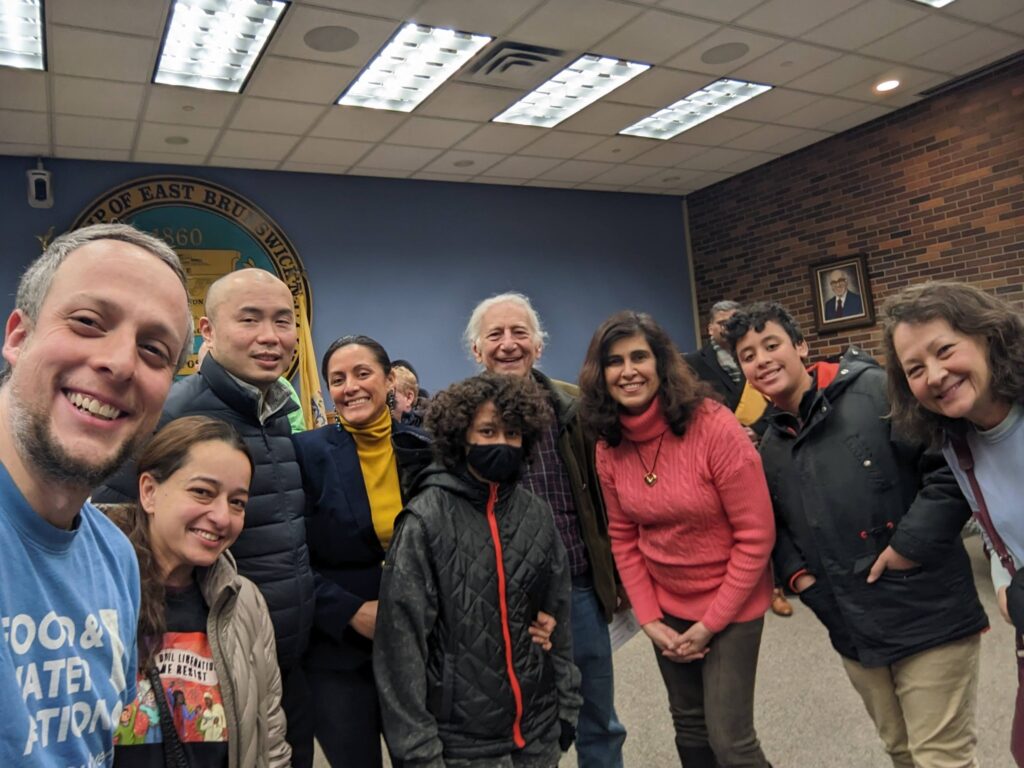How to Stop a Gas Power Plant: Our Victory in Woodbridge, NJ
Published Nov 20, 2023

Our victory stopping CPV’s fracked gas plant in Woodbridge is a huge win for environmental justice communities and the climate. Here’s how we did it.
Throughout Woodbridge, NJ, air pollution and asthma are a daily part of many residents’ lives. The area is highly industrialized. The state’s two largest highways intersect here, bringing hundreds of thousands of cars’ worth of exhaust pollution each day. It’s also home to two of Middlesex County’s six fossil fuel power plants. So when we heard news of plans for a third plant, we knew we had to stop it.
For years, our Jersey team has worked with a broad coalition opposing the proposed plant. This fall, the campaign saw victory, as the developer finally announced it was dropping the project. Here’s how it all went down.
CPV Proposes Another Dirty Gas Plant in Woodbridge
In 2016, the company Competitive Power Ventures (CPV) began operating a fracked gas power plant in the Keasbey neighborhood of Woodbridge. But one plant wasn’t enough.
That same year, it proposed a second on the site. Not only that — the CPV2 plant would have become the biggest fracked gas power plant in New Jersey.
This would be horrible for the health of nearby communities, and CPV knew it. In its permit application to the state, the company predicted its new plant would emit hundreds of tons of toxic pollution every year, including dangerous sulfur dioxide, carbon monoxide, ammonia, volatile organic compounds, and lead.
Woodbridge and its neighbors have long-faced terrible air quality and related health problems like asthma. The American Lung Association has previously given Middlesex County a grade “F” for ground-level ozone until this year. (Ozone worsens lung problems and comes from sources like car exhaust and burning gas.) Moreover, Woodbridge is in the top fifth of New Jersey municipalities when it comes to health risks from toxic air pollution, including cancer.
To add insult to injury, we later learned that CPV’s first plant, CPV1, had been racking up pollution violations for years. On the same day as CPV2’s one and only environmental justice hearing, the New Jersey Department of Environmental Protection (DEP) fined CPV $69,000 for violations at CPV1.
Many of these fines were for violating the state’s Air Pollution Control Act. And though the violations dated all the way back to 2016, DEP only notified the public by announcing these fines in 2023.
This is part of a clear pattern in New Jersey. Black, Brown, and low-income communities disproportionately face pollution from dirty industries, huge highways, and gas plants. We were seeing it again with CPV’s proposal in Woodbridge’s majority-Hispanic neighborhood of Keasbey.
Governor Murphy Has Failed Woodbridge and New Jerseyans
New Jersey has much-touted state laws that should be addressing environmental injustices and stopping dirty fossil fuel projects. But Governor Murphy’s administration has directly contradicted them by refusing to oppose the CPV plant.
In February 2023, Governor Murphy proudly declared a goal to move New Jersey to 100% clean energy by 2035. Despite this, the administration did not oppose CPV2, which promised 2.3 million tons of greenhouse gasses every year.
Additionally, Governor Murphy signed an environmental justice law three years ago, applauded as one of the strongest in the country. Environmental justice communities — disproportionately low-income and majority-people of color — have long suffered from pollution because of discriminatory policies and environmental racism. The Governor’s new law was intended and designed to protect them from more of it.
This would have been welcome for residents in Keasbey. In fact, the DEP has designated Keasbey an “overburdened community” under the environmental justice law.
But frustratingly, the administration took more than two years to write the rules for implementing the law, and it didn’t adopt them until April of 2023. This allowed major polluting facilities to vie for state approval before the law could be implemented.
Even after adopting the long-awaited rules, Governor Murphy’s DEP declined to apply the law to CPV’s proposed gas plant, and the Governor has failed to publicly oppose the plant. A state administrative order that sought to follow “the spirit” of the law failed to actually deliver environmental justice to the residents of Keasbey, Woodbridge, and neighboring communities.
We’re here in Woodbridge to call on @GovMurphy to reject CPV’s fracked gas power plant proposal in Keasbey #EnvironmentalJustice #ClimateEmergency pic.twitter.com/ZbUvzzpioi
— Food & Water Watch NJ (@FWWNewJersey) June 3, 2023
Our Campaign to Stop CPV2 in Woodbridge
After proposing its second Woodbridge plant, CPV’s application sat with the DEP for years. But that changed in 2021, when the company finished the air modeling needed to move its application forward.
Around the same time, Food & Water Watch’s work around other gas plants was gaining steam. The pattern was becoming increasingly clear: fossil fuel projects threatened environmental justice communities across the state. And New Jerseyans had had enough of it. So as CPV2’s gears began turning again, we poured resources into efforts to stop it.
Though Woodbridge’s mayor and Town Council had already greenlit CPV2, we knew we could throw a wrench in at the state level. CPV2 still needed a key air permit to operate the plant.
That made our targets clear: the DEP, which would approve or deny the permit, and Governor Murphy, to whom the DEP is ultimately accountable.
From 2021 to 2023, our team took on several strategies to gain ground. Here are three:
1. Building a Strong, Diverse Coalition of Allies
We couldn’t do this alone. To stop CPV2, we had to create a strong coalition with frontline communities and organizations. Coalitions allow us to share resources, connections, and tactics. In coalitions, we build relationships and people power across intertwined issues like social justice and environmental protection.
Food & Water Watch became a founding member of the “Don’t Gas Middlesex” coalition, made up of over 50 organizations opposing CPV2. The Perth Amboy Area Branch of the NAACP, Our Revolution Middlesex County, and Empower NJ were just some of the key organizations that worked with us in this fight.
2. Gathering Support From Neighboring Municipalities
We knew we could build support and publicity for our campaign by driving neighboring municipalities to join our opposition. But though we had a strong case, we also knew we had our work cut out for us.
Woodbridge is home to a powerful political machine in arguably the most powerful county in New Jersey. CPV2 enjoyed strong support from the mayor; the Woodbridge Township Council had already signed off on a 30-year tax break for the Keasbey site if CPV2 were built. It would be a challenge to get neighboring leaders to oppose the Woodbridge machine.
But we also knew that we had the facts on our side — we just needed to get leaders to see them. CPV2 wouldn’t have just hurt Woodbridge. Air pollution doesn’t recognize township borders, so communities across the region faced health risks, too. Notably, more than 70 schools would have been within 6 miles of CPV’s power plants, exposing children to dangerous pollutants.
After years of speaking out at dozens of local meetings, 16 elected governing bodies came out in opposition to the Woodbridge plant. That included neighboring Somerset County and 10 towns and cities in Middlesex County.

3. Cultivating Consistency and Persistence With Volunteers and Organizers
Our work on this campaign really kicked into high gear in February of 2022. That month, we began holding volunteer meetings every two weeks. Dozens of volunteers joined each meeting to get updates, make plans, coordinate our tactics, and build friendships.
Soon, we had a strong group of determined activists willing to try many different tactics.
We rallied at the state capitol and in front of Woodbridge Town Hall; we marched through the streets of Woodbridge and all over the state to oppose CPV2, as well as all seven fossil fuel expansion projects planned for New Jersey.
We also delivered petitions to the Governor’s office and followed him to events throughout the state to make our voices heard. Hundreds of folks showed up for in-person actions, and thousands of people signed petitions and sent messages online.
The Turning Point: CPV’s One and Only Environmental Justice Hearing
After the Murphy administration decided that the environmental justice law didn’t fully apply to CPV2, it ordered CPV to organize a single public meeting to hear and address environmental justice concerns. CPV scheduled the meeting for February 2023.
CPV’s response to public concerns had been messy from the start. Its announcements and documentation were confusing and misleading. It had errors on public materials, directed residents to a web page missing key documents, and gave too little and too short a notice for its public hearing.
Then came the hearing itself — the one and only chance for many to voice their concerns. It was scheduled on Microsoft Teams. There was no Spanish language interpreter, and several would-be participants couldn’t join by phone. But we were not going to let CPV’s shoddy planning silence us.
We held a huge rally the week before, with nearly 50 supporters joining us. Throughout February, we worked to get the word out and boost turnout.
And we succeeded. More than 150 people attended. The public testimonies went on for three hours instead of the planned two. Out of 40 speakers, 38 were vehemently opposed to the project, and several were quoted prominently in major media coverage of the hearing.
We also mobilized folks to send in hundreds of written comments. Ultimately, NAACP Perth Amboy secured a 30-day extension for the comment period, delaying the project.
By the fall, CPV conceded defeat. Thanks to our opposition, it missed a key deadline under its contract with the grid operator. CPV announced in October that it was officially pulling its plans. We successfully killed the plant.
The Fight Against Fossil Fuels in New Jersey Continues
The Woodbridge victory was a massive win for people power and grassroots organizing. Years of loud, diverse, and steadfast opposition delayed the project and ultimately made it untenable. The residents of Woodbridge and its neighbors can breathe more easily without the threat of yet another gas plant.
Meanwhile, the fight for environmental justice in New Jersey continues.
Two more dirty gas plants are still on the table at the state level: one planned by NJ Transit in Kearny and another planned in Newark’s Ironbound neighborhood by the Passaic Valley Sewerage Commission. Food & Water Watch is also fighting two major pipeline projects, a turnpike expansion, and a liquefied natural gas terminal in New Jersey.
Governor Murphy has remained silent on Woodbridge — he must not do the same for these other fossil fuel projects. His administration has the power to stop them. Ultimately, environmental justice laws and climate goals mean little unless New Jersey actually acts to stop dirty, climate-wrecking projects.
Help us stop environmental injustice in New Jersey, starting with NJ Transit’s gas power plant. Send a message to Governor Murphy urging him to stop NJ Transit’s toxic plans!
Enjoyed this article?
Sign up for updates.
TO TOP


